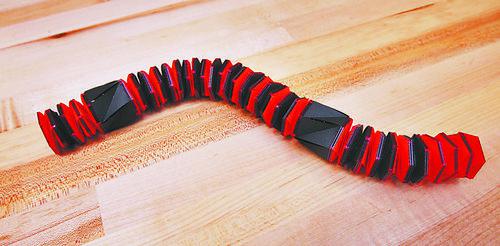
The soft robot is made up of multiple parts that can fold into a flat disk and extend into a cylinder. Image credit: Princeton University
Engineers at Princeton University and North Carolina State University have combined ancient origami techniques with modern materials science to create a soft robot that can easily navigate a maze. In an article published in the latest issue of the journal Proceedings of the National Academy of Sciences, the researchers describe their process of creating a robot with modular cylindrical parts.
Steering soft robots has always been challenging because traditional steering devices increase the rigidity of the robot and reduce its flexibility. This new design overcomes these problems by building the steering system directly into the robot body. The concept of modular soft robots also gives people a further understanding of future robots that can grow, repair and develop new functions.
The newly created robot has the ability to assemble and disassemble on the move, which enables it to work both as a single robot and as a group. Each part is an independent unit that can communicate with each other and assemble on command, and can also be easily separated and connected again using magnets.
The researchers built the robot using cylindrical sections of an origami form known as a Kreslin pattern. The pattern allows each segment to twist into a flat disk and expand back into a cylinder. This twisting and stretching motion is the basis for the robot's ability to crawl and change direction. By folding a portion of the cylinder, the robot can also change direction as it moves forward.
The most challenging part of this work is to develop a mechanism to drive and manipulate the bending and folding motion of the robot. The researchers used two materials that react differently when heated: liquid crystal elastomer (contracts when heated) and polyimide (expands when heated), and combined them into thin strips along the creases of the Kresslin pattern. A stretchable heater made of silver nanowires is installed at each fold. The current on the nanowire heater heats the control strip, causing the two materials to deform due to different thermal expansion coefficients, thereby inducing folding. By adjusting the current and control strips, the researchers can precisely control folding and bending, driving the robot to move and turn precisely.
Previous article:Megvii presents high-density storage and picking integrated solutions and a variety of new robot products at LogiMAT
Next article:element14 Community launches "Shift It - Warehouse Automation Challenge"
- Popular Resources
- Popular amplifiers
- Using IMU to enhance robot positioning: a fundamental technology for accurate navigation
- Researchers develop self-learning robot that can clean washbasins like humans
- Universal Robots launches UR AI Accelerator to inject new AI power into collaborative robots
- The first batch of national standards for embodied intelligence of humanoid robots were released: divided into 4 levels according to limb movement, upper limb operation, etc.
- New chapter in payload: Universal Robots’ new generation UR20 and UR30 have upgraded performance
- Humanoid robots drive the demand for frameless torque motors, and manufacturers are actively deploying
- MiR Launches New Fleet Management Software MiR Fleet Enterprise, Setting New Standards in Scalability and Cybersecurity for Autonomous Mobile Robots
- Nidec Drive Technology produces harmonic reducers for the first time in China, growing together with the Chinese robotics industry
- DC motor driver chip, low voltage, high current, single full-bridge driver - Ruimeng MS31211
- Innolux's intelligent steer-by-wire solution makes cars smarter and safer
- 8051 MCU - Parity Check
- How to efficiently balance the sensitivity of tactile sensing interfaces
- What should I do if the servo motor shakes? What causes the servo motor to shake quickly?
- 【Brushless Motor】Analysis of three-phase BLDC motor and sharing of two popular development boards
- Midea Industrial Technology's subsidiaries Clou Electronics and Hekang New Energy jointly appeared at the Munich Battery Energy Storage Exhibition and Solar Energy Exhibition
- Guoxin Sichen | Application of ferroelectric memory PB85RS2MC in power battery management, with a capacity of 2M
- Analysis of common faults of frequency converter
- In a head-on competition with Qualcomm, what kind of cockpit products has Intel come up with?
- Dalian Rongke's all-vanadium liquid flow battery energy storage equipment industrialization project has entered the sprint stage before production
- Allegro MicroSystems Introduces Advanced Magnetic and Inductive Position Sensing Solutions at Electronica 2024
- Car key in the left hand, liveness detection radar in the right hand, UWB is imperative for cars!
- After a decade of rapid development, domestic CIS has entered the market
- Aegis Dagger Battery + Thor EM-i Super Hybrid, Geely New Energy has thrown out two "king bombs"
- A brief discussion on functional safety - fault, error, and failure
- In the smart car 2.0 cycle, these core industry chains are facing major opportunities!
- The United States and Japan are developing new batteries. CATL faces challenges? How should China's new energy battery industry respond?
- Murata launches high-precision 6-axis inertial sensor for automobiles
- Ford patents pre-charge alarm to help save costs and respond to emergencies
- New real-time microcontroller system from Texas Instruments enables smarter processing in automotive and industrial applications
- Chapter 5 GD32VF103C START PWM
- Inter-core communication mechanism of multi-core processor
- Summary of performance indicators of integrated operational amplifiers
- Things you must know about Gallium Nitride (GaN): Introduction (Part 1)!
- EEWORLD University ---- Cisco CCNA+CCNP Learning Tutorial
- IIC communication of msp430g2553
- What software do you usually use when doing circuit simulation?
- About LoRa networking issues?
- Comparison of MC34063 circuit structures
- The board for showing goods + collecting dust

 CA3160TX
CA3160TX














 京公网安备 11010802033920号
京公网安备 11010802033920号